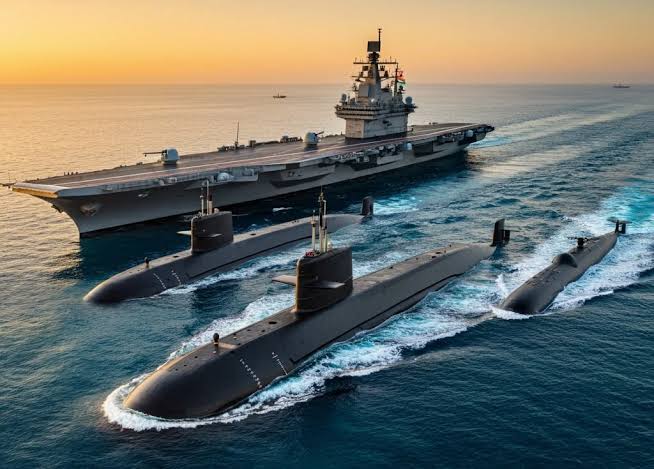Powerful Nuclear reactors being developed for Aircraft Carriers and Submarines

BARC or Bhabha Atomic Research Centre has already taken the initiative to develop a 190-MW nuclear reactor for India’s future submarines and Aircraft Carriers.
This strategic move will enhance India’s naval capabilities while promoting self-reliance in defence technology.
To navigate the Dangerous Waters these advancements are expected to play a vital role in ensuring that in the foreseeable future India Navy is equipped with Six aircraft carriers, 12 x Nuclear SSBNs and in time to come with 24 X SSGNs.
The new reactor is specifically designed for upcoming classes of submarines, including the P77 nuclear attack submarines (SSNs) and the S-5 ballistic missile submarines (SSBNs).
The current fleet, utilizes an 83-MW pressurized light-water reactor. The enhanced power output of the new reactor will allow submarines to operate more efficiently and with additional speed for extended periods, thereby improving stealth and operational capabilities.
The reactor will be designed in a twin configuration, allowing it to provide sufficient power for larger vessels, such as a potential future nuclear aircraft carrier weighing around 70,000 tons.
This approach not only meets the needs of submarines but also lays groundwork for future naval projects.
Tailored for nuclear attack submarines (SSN), this variant can handle dynamic power demands necessary for rapid manoeuvres and operational flexibility.
Designed for endurance missions (SSBN), this variant focuses on maintaining steady power output for long-duration stealth operations.
Building on the technology demonstrated by the Arihant-class reactors, the new design is expected to incorporate advanced safety features, improved fuel efficiency, and reduced maintenance requirements.
This ensures that the reactors can withstand harsh underwater environments while remaining safe and sustainable for extended missions.
The development of this reactor marks a significant step towards self-reliance in India’s defence technology. By creating an indigenous nuclear reactor, India aims to reduce dependence on foreign technology and enhance its strategic capabilities amid rising regional tensions.
The reactor’s design allows for quick adjustments in power output, which is crucial for SSNs that require rapid changes in speed and depth during operations. This operational flexibility is essential for effective naval warfare.
The development of this reactor is of strategic importance and crucial for several reasons. The initiative reflects India’s commitment to self-sufficiency in defence technology, reducing reliance on foreign technology and expertise.
BARC has been instrumental in developing indigenous nuclear capabilities since its inception in 1954.
The urgency for advanced nuclear submarines has intensified due to strategic shifts in the Indo-Pacific region and challenges posed by neighbouring adversary countries.
The new reactor will support the construction of advanced submarines that can carry more sophisticated missile systems, such as the K-4 ballistic missile with a range of up to 3,500 km and future ICBM of 12000km+ range.
India has already commissioned its first two nuclear-powered ballistic missile submarines (SSBNs), INS Arihant and INS Arighat. The latter was commissioned in August 2024 and is equipped to carry K-4 ballistic missiles with a range of 3,500 kilometers.
The third SSBN, INS Aridhaman, is expected to be commissioned in early 2025, further enhancing India’s sea-based nuclear deterrence capabilities.
This ongoing project aims to construct six indigenous nuclear-powered attack submarines (SSNs). The Indian government recently approved plans to build two SSNs under Project 77, with a total estimated cost of ₹40,000 crore (approximately $5 billion).
These submarines will be designed for conventional warfare and are expected to take about 10-12 years to complete. Very soon a parallel line for six more will have to be started.
After all Indian Navy needs to have 24 of them by mid 2040’s. For the SSBN fleet, India is already building a total of four Arihant-class SSBNs and at least two more advanced S-5 class submarines.
The S-5 class will feature improved capabilities, including a larger payload capacity for ballistic missiles. It needs to build six more in next phase.
Approximately 95% of the components for the new SSNs will be sourced domestically, reflecting India’s commitment to self-reliance in defence manufacturing. This move aligns with broader national objectives to enhance indigenous defence capabilities while reducing dependence on foreign technology.
The establishment of specialized facilities, such as the very-low-frequency (VLF) communication station at Vikarabad, is essential for maintaining secure communications with deployed submarines.
Additionally, the new submarine base at INS Varsha in the Bay of Bengal will provide strategic advantages during operations against potential adversaries.




